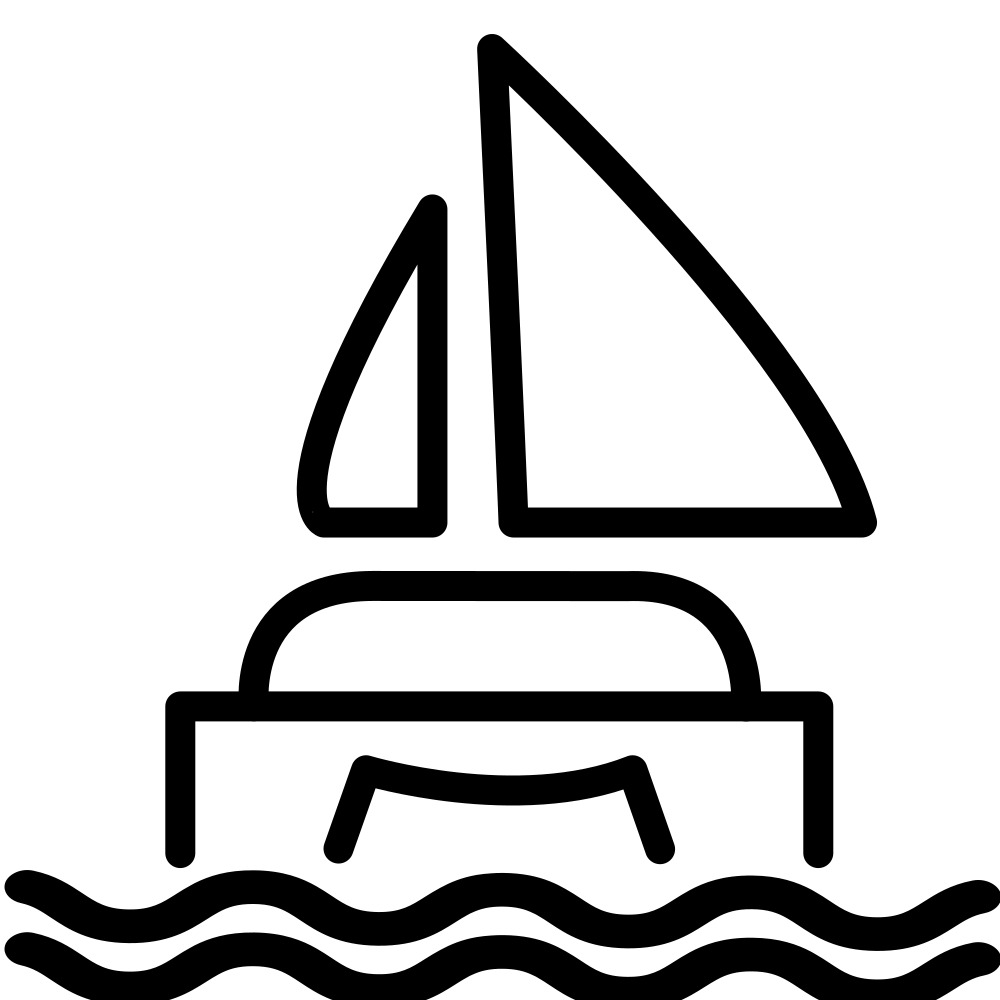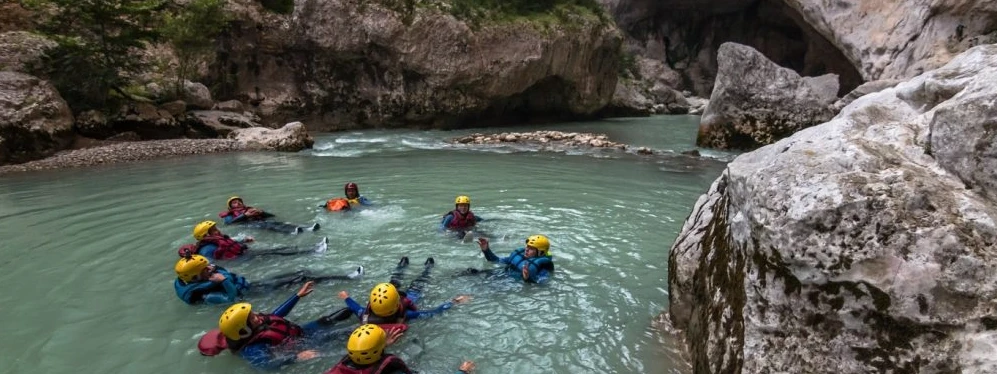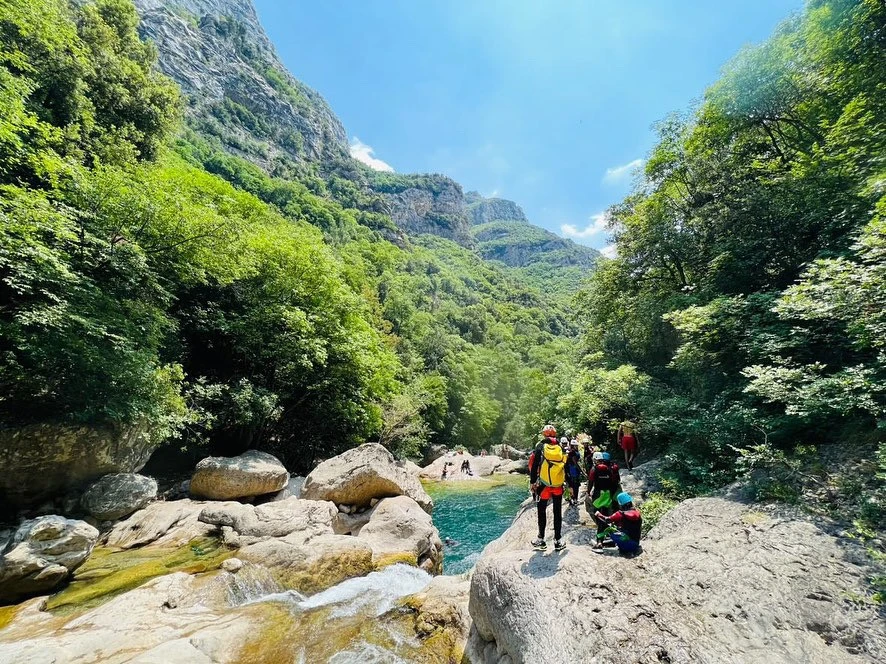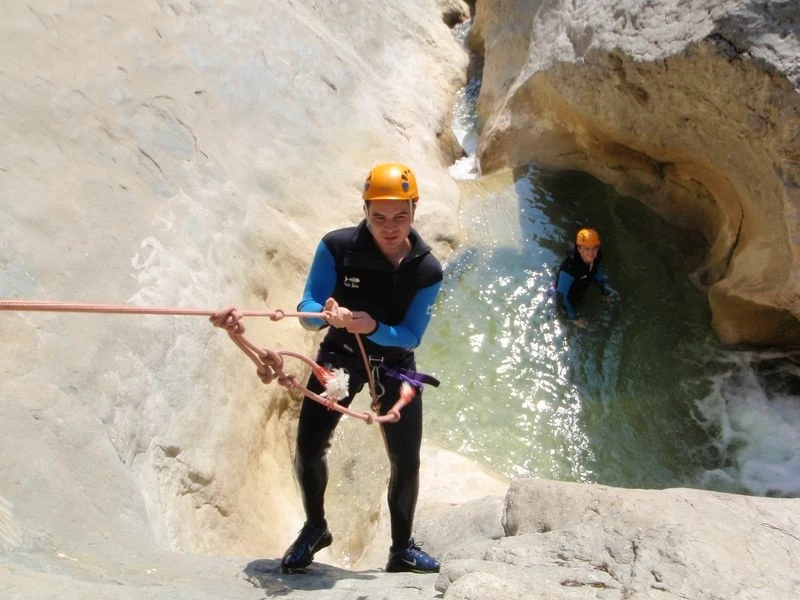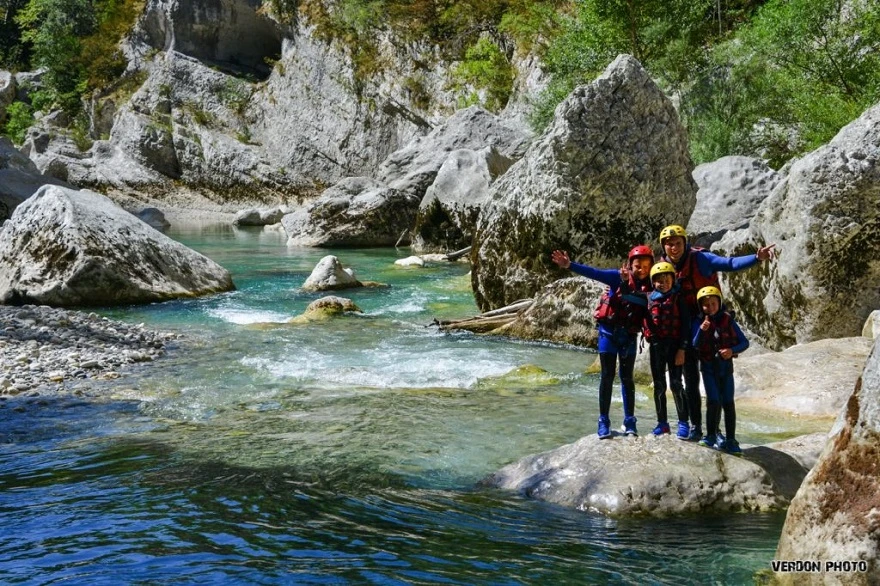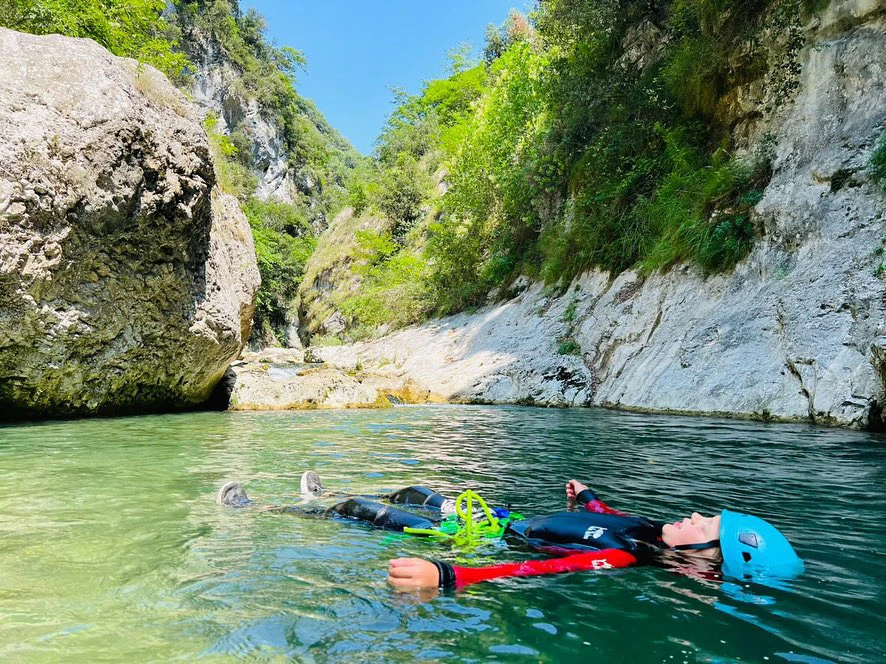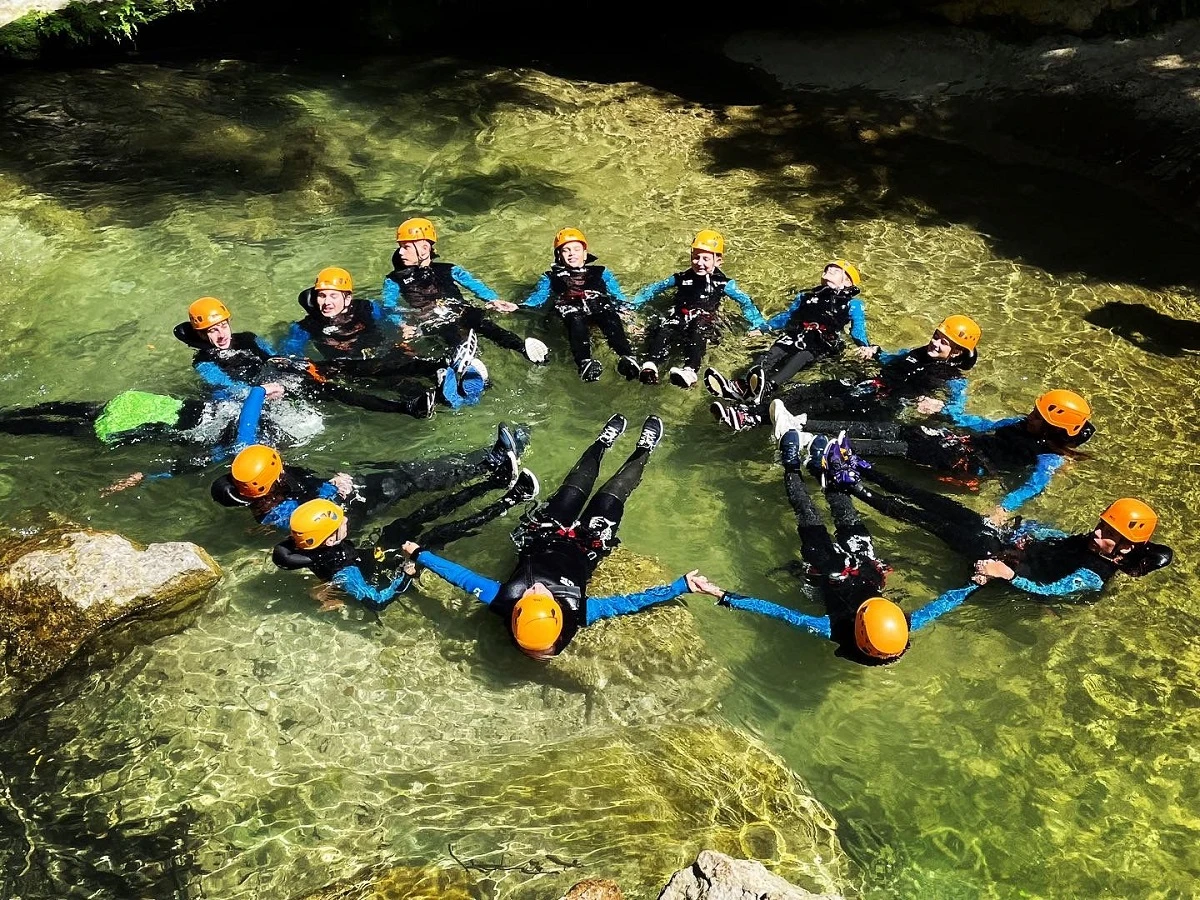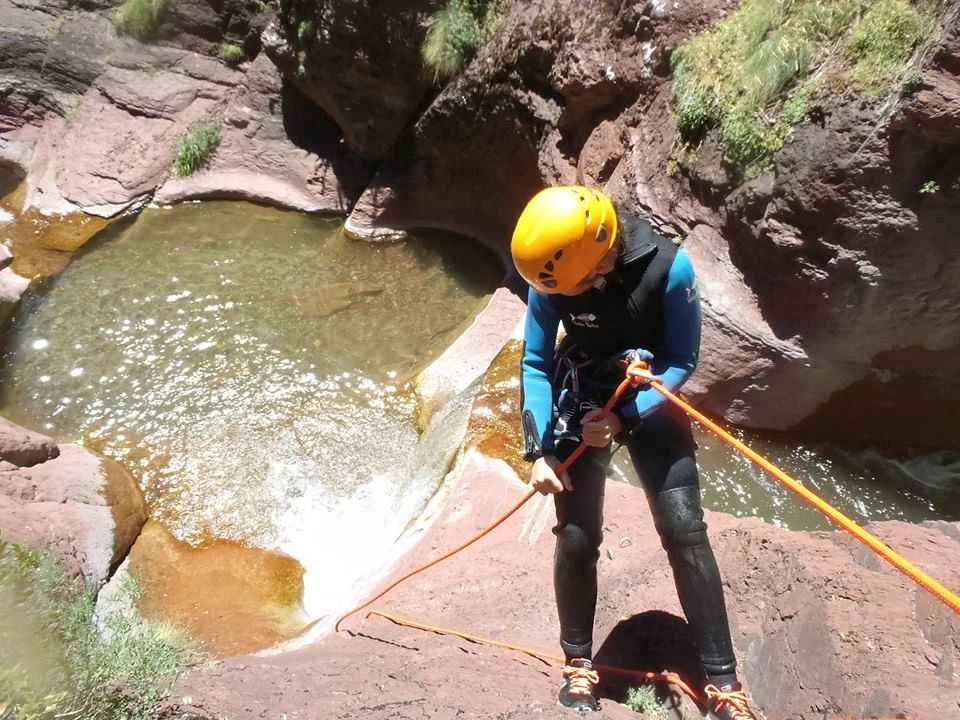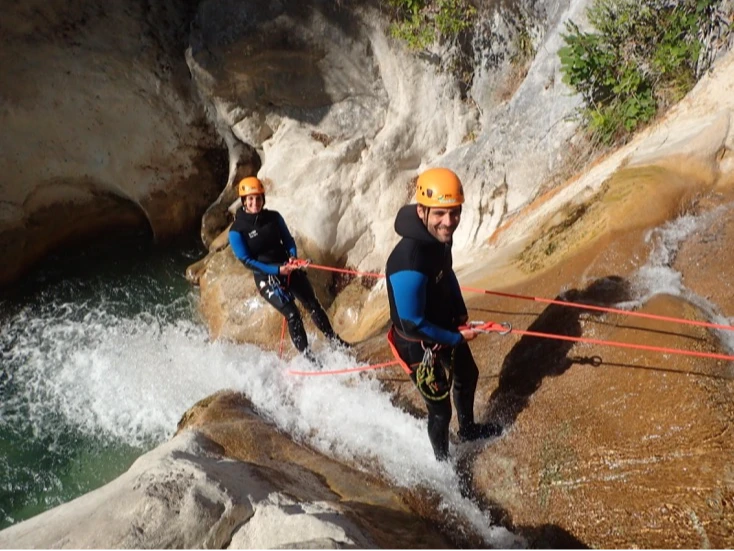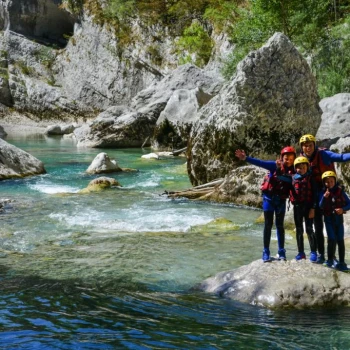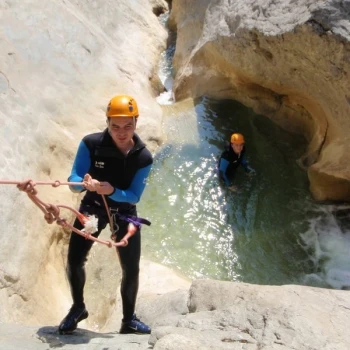What is canyoning?
Canyoning is an outdoor activity that involves descending a canyon — a narrow valley with steep walls, often carved over millennia by the natural erosion of a river.
Canyoning combines several techniques to move along a river:
- Aquatic hiking – Moving through the riverbed, alternating between walking and swimming depending on the depth and flow of the water.
- Jumps – Leaping into crystal-clear pools, enjoying a rush of adrenaline while immersing yourself in stunning scenery.
- Abseiling – Descending waterfalls with ropes, similar to rock climbing, requiring both skill and control for a safe descent.
- Slides – Shooting down natural rock slides sculpted by the water, adding a playful and refreshing touch to the experience.
Canyoning offers a unique mix of sport, nature, and exploration, all set in breathtaking landscapes. Whether you’re seeking an adrenaline rush or simply want to immerse yourself in awe-inspiring surroundings, this activity is especially enjoyable in summer, when the warm temperatures make the canyon’s cool waters even more inviting.
A brief history of canyoning – its origins and how the activity has evolved.
Canyoning, as we know it today, was born in the 1950s in France. Originally, the pioneers of this activity were passionate speleologists, specialists in cave exploration. Their curiosity led them beyond the caverns to explore deep gorges and valleys carved by rivers — environments often inaccessible by conventional means. These explorers adapted their caving skills to the unique challenges of canyons, using abseiling, swimming, and jumping techniques to navigate through these rugged terrains.
Over the decades, canyoning evolved and became more popular, transforming from a niche adventure activity for enthusiasts into a sport accessible to the general public. Specialized equipment, improved safety techniques, and the rising popularity of outdoor activities all contributed to its growth. Today, canyoning is practiced all over the world, offering thrill-seekers the opportunity to explore breathtaking landscapes while taking on natural challenges. Canyoning destinations have multiplied — from the French Alps to the American canyons, and the spectacular gorges of the Canary Islands — making the sport accessible to an ever-growing audience.
Who can go canyoning? How to choose your route?
Canyoning is an activity accessible to a wide audience, from beginners to seasoned athletes. Whether you’re a novice looking for a refreshing adventure or a thrill-seeker in search of technical challenges, there are canyoning routes to suit all skill levels.
Canyoning for children – In general, children can take part in canyoning from the age of 8, provided the routes are adapted to their age and skill level. Family-friendly and beginner routes are specifically designed to ensure a fun and safe experience for younger participants. On child-friendly canyoning routes, jumps can be skipped if they don’t feel ready, and it’s possible to opt for aquatic hikes without abseiling, where no ropes are used. It’s also important to choose a canyon with a short and accessible approach walk to make the outing enjoyable for the whole family.
Canyoning for adults – Good physical condition is essential, as sportier canyoning routes are more demanding. They often include abseils, jumps of over 10 meters, and slides, requiring fitness, some athletic ability, and sometimes ease with heights. Children can join these more challenging routes from the age of 12, provided they are sporty and not intimidated by the challenges involved.
Required skills – No specific prior skills are needed to start canyoning, although basic swimming ability and self-confidence are helpful. Beginners are accompanied by qualified instructors who provide full training on safety techniques and necessary skills. Professional canyoning guides adapt the sessions to the abilities and expectations of each participant, ensuring a safe and enjoyable experience.
Canyoning is a fantastic opportunity to explore breathtaking landscapes, build self-confidence, and share unforgettable moments with friends or family. Whether you’re a first-time explorer or an experienced adventurer, there’s a canyoning route out there for you, tailored to your needs and level.
The benefits of canyoning
Canyoning is much more than just an adventure – it’s an activity that offers numerous physical and mental benefits.
Physical benefits:
- A full-body workout – Canyoning engages many muscle groups: arms for climbing, legs for jumping and swimming, and your heart to keep up the pace. It’s a bit like doing gymnastics, swimming, and rock climbing all at once!
- Gentle fitness – You might not notice it, but canyoning burns a lot of energy. It’s an excellent way to let off steam and stay in shape, all while having fun without even realizing it.
- Strength and balance – By jumping, climbing, and walking on slippery surfaces, you’ll develop strength, balance, and coordination.
Mental benefits:
- Pushing your limits – Canyoning is a bit like a personal challenge. By overcoming obstacles, you’ll gain confidence and feel stronger.
- Total disconnection – Far from noise and pollution, you’ll be able to recharge and reconnect with nature.
- Guaranteed happiness – Canyoning is an activity that brings a lot of joy. Between the thrills, the stunning landscapes, and the group’s good vibes, you’re bound to have a great time!
Where to go canyoning on the French Riviera?
The French Riviera is a top destination for canyoning enthusiasts, offering breathtaking scenery and a variety of routes suited to all levels. The Gorges du Verdon, often considered the crown jewel of canyoning in France, feature spectacular routes with abseils, jumps into crystal-clear pools, and natural slides. This region is perfect for those seeking both thrilling experiences and magnificent landscapes.
The Alpes-Maritimes and the Var also boast numerous exceptional canyoning sites. In the Alpes-Maritimes, canyons such as the Gorges du Loup, the Vésubie, and the Roya offer captivating routes for all abilities. The Var, meanwhile, is home to fascinating itineraries like the Siagne and the Artuby rivers, which charm visitors with their diverse landscapes and challenges tailored to both families and seasoned athletes.
To find the best canyoning spots near you, check out our dedicated articles, such as “The Best Canyoning Sites Around Nice” and “Where to Go Canyoning Near Fréjus.” These guides will lead you to the most recommended locations, providing detailed information on routes, difficulty levels, and tips to make the most of your canyoning adventure.
When is the best time to go canyoning?
The ideal season for canyoning generally runs from spring to autumn, from April 1 to October 31. Each season offers its own advantages:
Spring – The days get longer, nature awakens, and temperatures are mild. It’s a great time to enjoy the first rays of sunshine. However, be mindful of heavy rains caused by snowmelt, which can quickly raise water levels in canyons. It is therefore essential to check the weather and water flow conditions before setting out.
Summer – The summer season is arguably the most popular time for canyoning. Temperatures are warm, the water is refreshing, and the days are long. It’s the perfect moment to swim in natural pools and soak up the sun.
Autumn – Autumn colors provide a stunning backdrop for your canyoning adventures. Temperatures are pleasant, and the days are still long. However, if summer has been particularly dry, water levels may be too low, making certain sections difficult or dangerous. It’s important to check hydrological conditions before you go.
Winter – Due to extremely low temperatures, canyon water becomes icy, making canyoning both dangerous and uncomfortable. Additionally, the risk of snowfall and ice significantly increases hazards. For these reasons, canyoning is prohibited in winter.
Whatever season you choose, it is always recommended to check weather conditions and water levels before heading out. Safety is essential, and by following these precautions, you can fully enjoy your adventure.
What equipment do you need for canyoning?
Essential Equipment for Your Canyoning Adventure
To enjoy a canyoning experience safely, having the right equipment is crucial.
Here’s what your canyoning provider will supply:
- Wetsuit – Protects you from the cold and prevents friction against rocks.
- Harness – Essential for keeping you secure during abseils.
- Helmet – Protects your head from impacts with rocks.
Lanyards and descender – Used for abseiling and other technical passages.
This equipment is carefully checked and maintained to ensure your safety throughout the activity.
In addition, you should bring the following yourself:
- Closed-toe sports shoes – Water shoes are not recommended as they lack sufficient grip and can be dangerous on rocky surfaces.
- A change of clothes – You’ll appreciate having something dry to wear after the adventure.
- A backpack – To carry your picnic, towel, and personal belongings.
- Water – Staying hydrated is essential, especially in hot weather.
- A snack – To regain energy after the effort.
- A towel – To dry off before changing.
With the right gear, you’ll be ready to fully enjoy your canyoning adventure in both safety and comfort.
Canyoning Glossary – Key Terms to Understand the Activity
Canyoning is an activity rich in technical terminology, which can sometimes be confusing for beginners. Here’s a small canyoning glossary with some key terms to help you better understand this activity:
- Canyon – A deep valley with steep walls, often carved by a river.
- Abseil – A technique used to safely descend vertical walls with the help of a rope and a descender. It’s essential for overcoming vertical obstacles.
- Pool – A large pocket of water formed by erosion, perfect for jumps and swims during the activity.
- Slide – A fast descent along smooth rock surfaces, often made slick by water, offering a sensation of speed and gliding.
- Jump – A leap from a height into a natural pool, usually controlled and measured to ensure participant safety.
- Descender – A device used to control the speed of descent during abseils, ensuring a safe and smooth rappel.
- Harness – Safety equipment that secures you to the rope during vertical descents and traverses.
- Lanyards – Safety lines attached to the harness, used to clip onto the rope or anchors, providing secure positioning during the activity.
- Natural slide – A smooth slope formed by rock, used for sliding down.
- White-water swimming – A swimming technique used in canyon sections with strong currents, requiring specific skills for safe navigation.
- Approach walk – The trek to reach the start of the canyoning route, which can vary in difficulty depending on the location.
- Ponton – A section where the canyon is wide enough to cross on foot or by swimming, often used for breaks or swimming.
- Traverse – A horizontal or slightly inclined passage along a rock face, often equipped with ropes for safety, used to bypass trickier or slippery sections.
- Anchor – A fixed point used to attach the rope, often a solid tree or rock, essential for abseils and overall safety.
Knowing these terms will help you better understand the instructions and techniques used during your canyoning outings.
Canyoning is an exhilarating activity that immerses you in breathtaking landscapes and delivers extraordinary sensations. Combining physical challenges, immersion in nature, and moments of pure joy, canyoning is the perfect aquatic adventure to recharge, push your limits, and experience intense emotions. Now that canyoning holds no more secrets for you, all that’s left is to try it for yourself. Explore our many canyoning spots on the French Riviera and enjoy an unforgettable experience!
Don’t wait any longer to dive into this thrilling adventure!
Is canyoning dangerous?
Like any outdoor activity, canyoning carries certain risks. However, when practiced in suitable conditions and with the proper equipment, it is a safe activity. Canyoning providers ensure that all safety measures are followed: you are supervised by experienced guides, and the equipment used (harness, helmet, wetsuit) is regularly checked. In addition, routes are adapted to different levels, from beginner to expert, allowing you to choose an itinerary based on your experience and physical abilities. To minimize risks, it is important to follow the guides’ instructions and strictly adhere to safety guidelines.
How much does a canyoning trip cost?
The cost of a canyoning trip varies depending on several factors, such as the duration of the activity, the difficulty of the route, the region, and the services offered by the provider. For example, some providers have facilities with changing rooms and secure lockers for your belongings, which can influence the price. Generally, a half-day of canyoning costs between €48 and €70 per person. A full day typically ranges from €70 to €80 per person. These prices usually include the equipment, supervision by a professional guide, and sometimes additional services such as transportation.
You can find many canyoning offers on the French Riviera here.
Do you need prior experience to go canyoning?
No prior experience is required to try canyoning. Many routes are specially designed for beginners and families, with varying levels of difficulty. Beginners are supervised by professional guides who provide training on basic techniques, safety, and equipment use before starting. These guides adapt the route and pace to each participant’s abilities, making it possible for everyone to enjoy the activity safely, even without previous experience. For more experienced adventurers, there are more technical and challenging routes that offer extra thrills.
What fitness level is required for canyoning?
The required fitness level depends on the chosen route. Canyoning is accessible to most people in good physical condition, even without prior experience. For beginners, there are routes that do not require great endurance or advanced technical skills. These often include walking, easy jumps, and sliding down natural rock slides. For more advanced routes, better physical fitness is recommended, as they may include abseils, higher jumps, and more technical passages. Before booking, it’s best to check the specific requirements of the route and choose one that matches your physical condition and comfort level with heights and water activities.
How to book a canyoning trip on the French Riviera?
On the Experience Côte d’Azur website, we offer many canyoning descents in iconic rivers of the French Riviera, such as the Verdon, the Gorges du Loup, the Vésubie, and the Roya. To book, we recommend browsing our offers, selecting the difficulty level that suits you, and then choosing the canyon that interests you most.
If you need personalized advice, feel free to call our team at +33 (0)4 94 19 10 60. You can also book directly on our website by selecting your preferred date in the calendar. You will receive confirmation of your booking within 24 hours.







